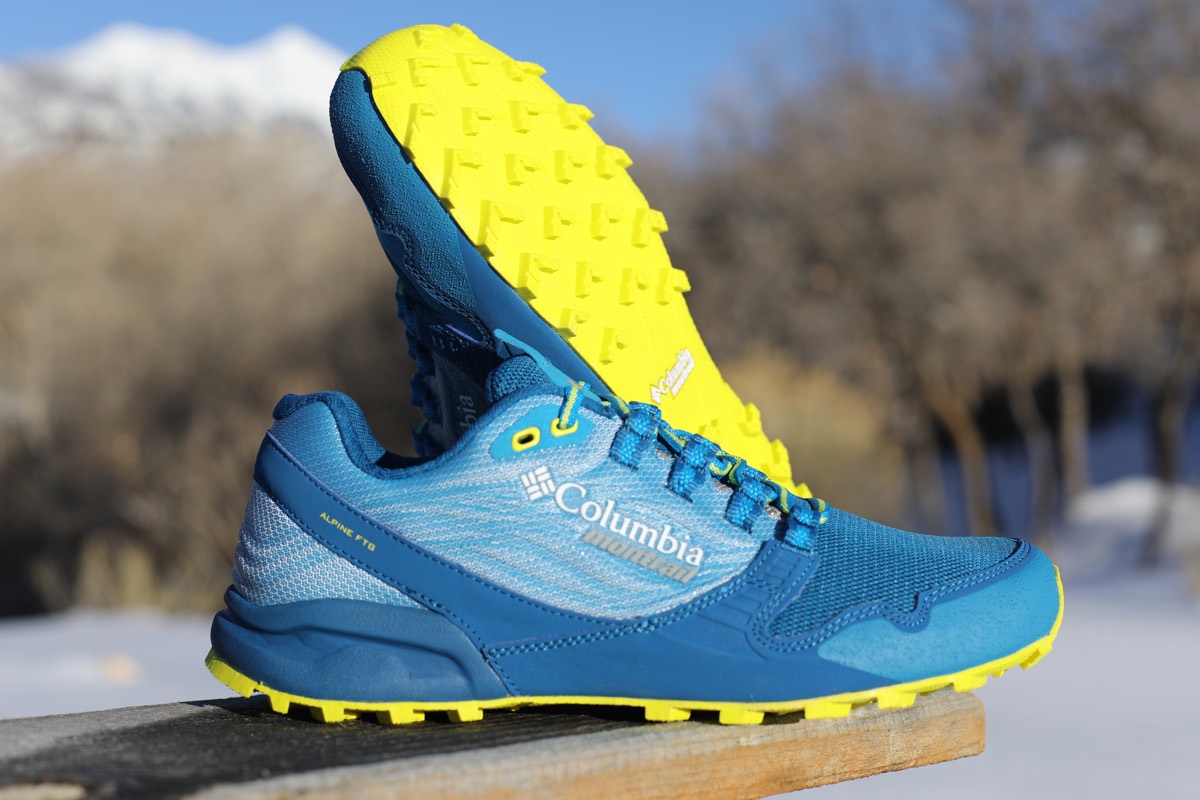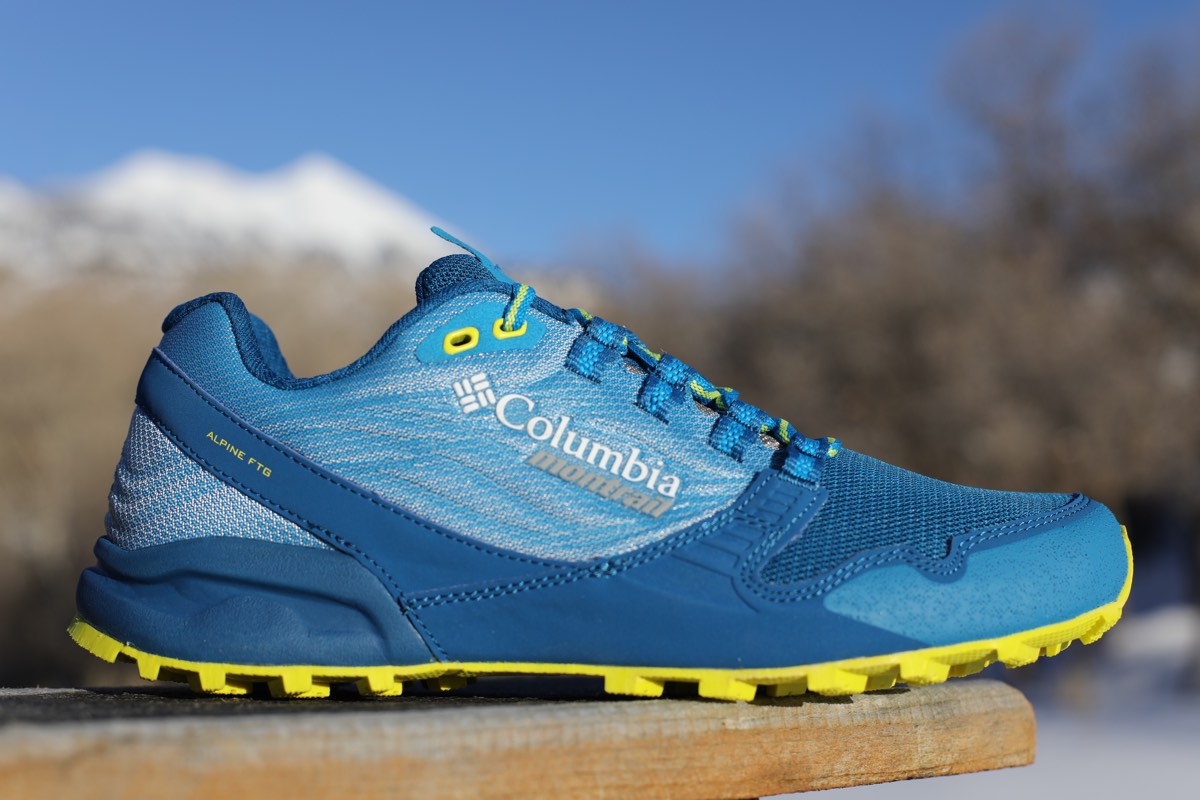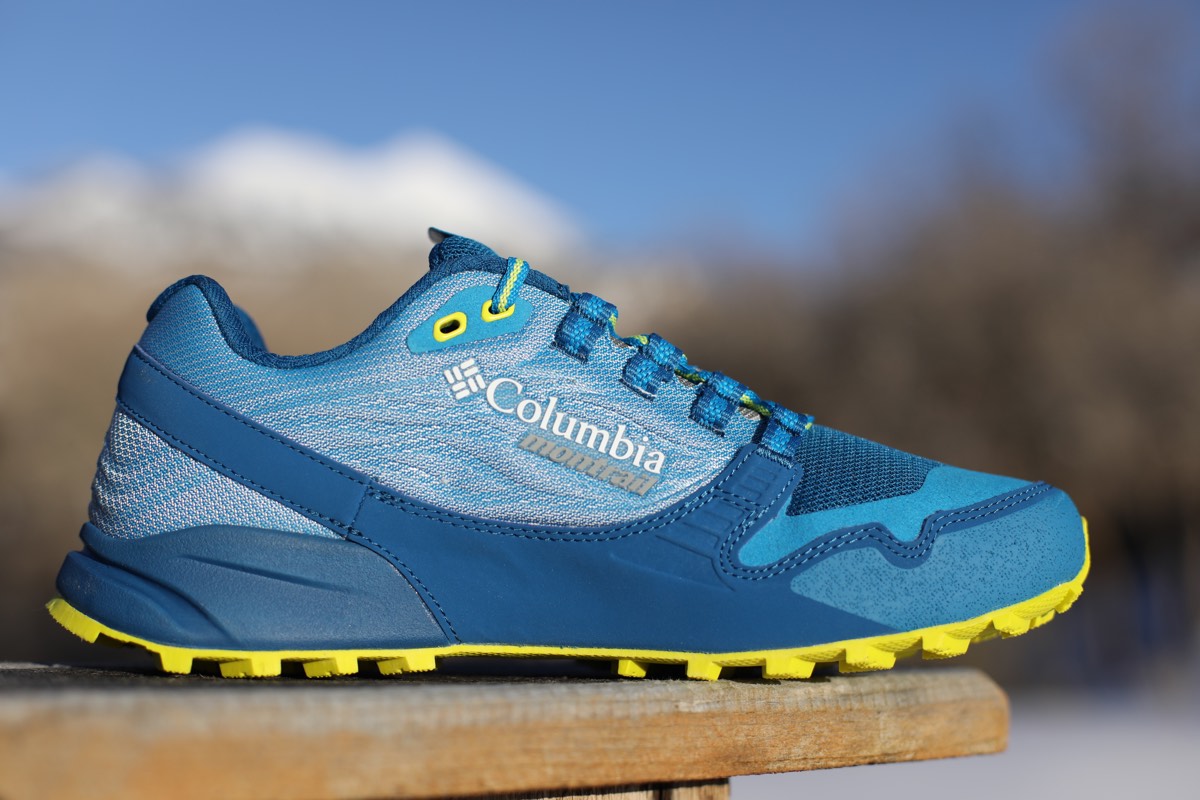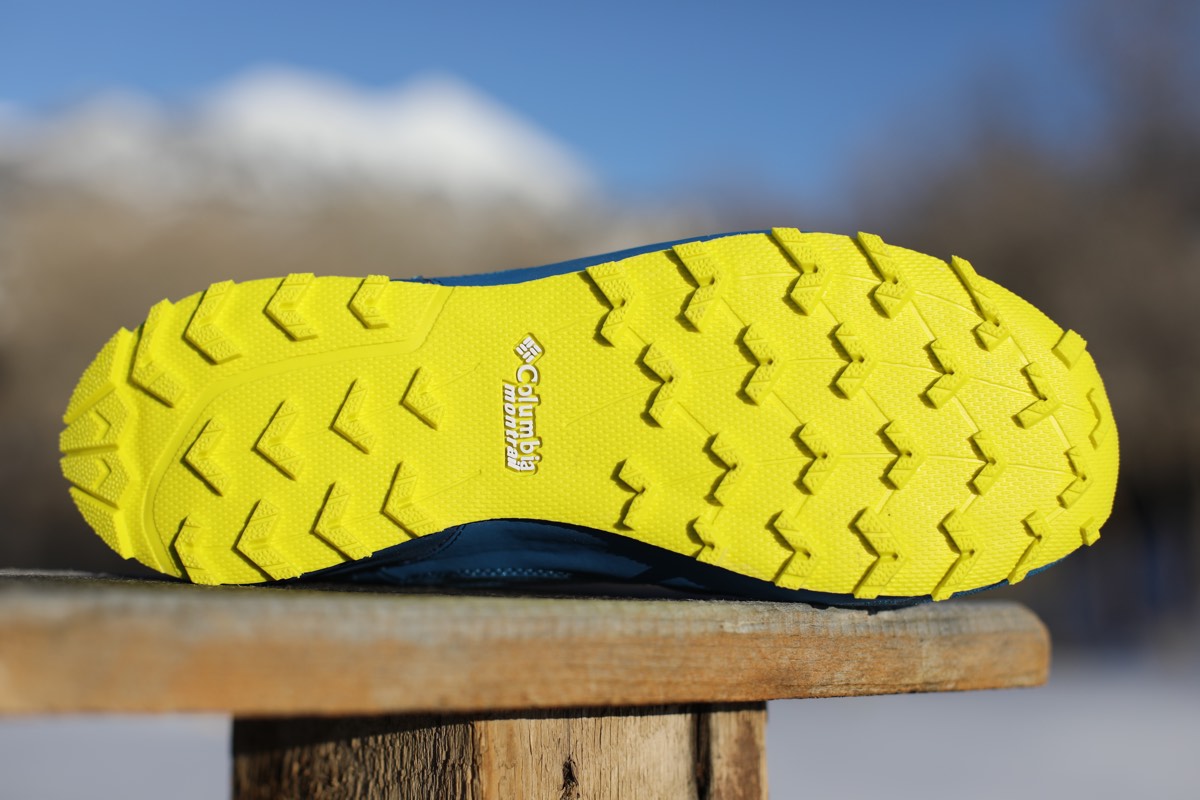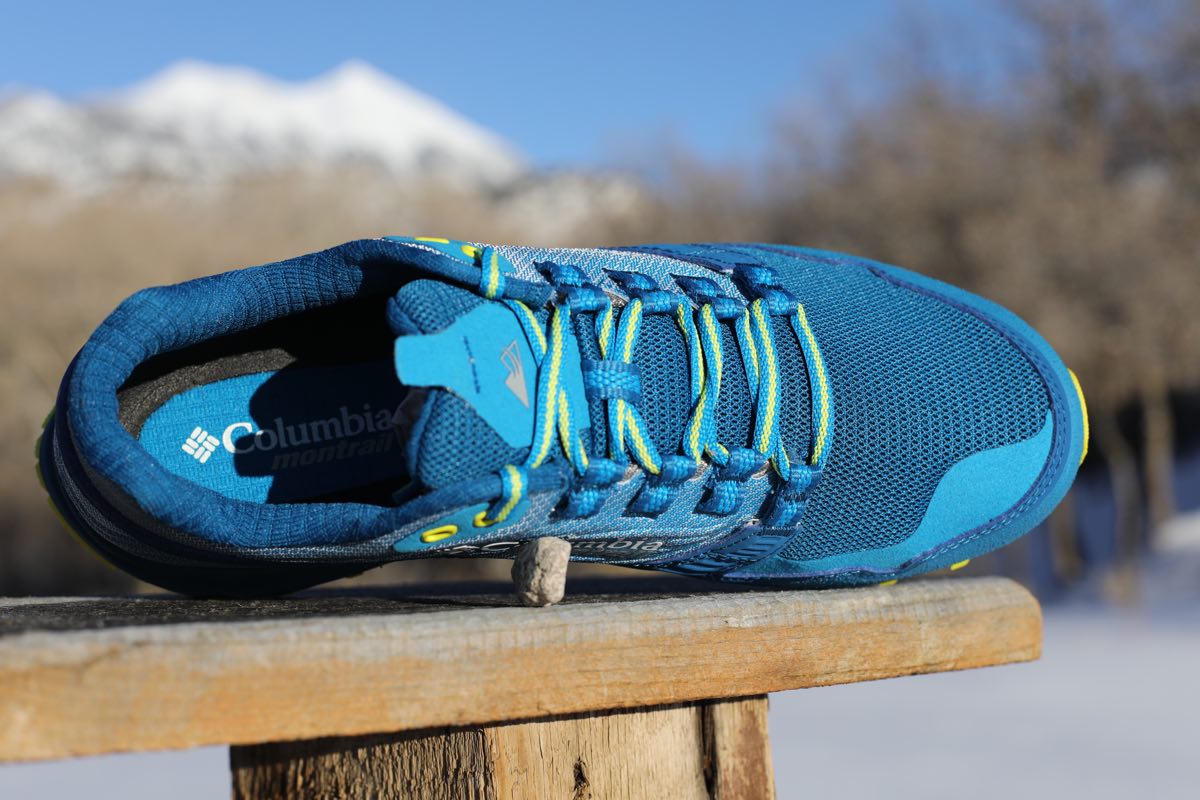Our Favorite Trail Running Shoes
Check out our Best Trail Running Shoes article to learn about our current favorite trail running shoes!
Columbia Montrail Alpine FTG Review
For those of you desiring a fairly aggressive outsole on a more ‘minimalist’-feeling trail shoe, Columbia Montrail’s Alpine FTG (Feel The Ground) ($130) is an interesting option. Weighing in at only 7.75 ounces (219 grams) in the women’s size 7 and 9 ounces (255 grams) in men’s size 9, the shoe feels light on the run and with 4mm lugs on the outsole, is ready and able to tackle a wide range of terrain. The 16mm heel/10mm forefoot stack height keeps the foot low to the ground and the shoe itself rather stable even on awkwardly cambered slabs. This is also a terrific time to scoop up a pair if you’re interested as the regular price has been reduced on some websites to $50 to $89 per pair.
Columbia Montrail Alpine FTG Upper
Columbia Montrail has decreased the weight of the Alpine FTG compared to similar trail running shoes in their line-up by employing new technology where TPU (thermoplastic polyurethane) yarn is heat molded into the mesh upper to add protection and structure at a lower weight. The material this creates on the sides and back of the shoe is excellent at keeping sand, water, and debris out without being overly hot during summer months. More open-pore mesh is used over the forefoot which is more breathable at the expense of some trail dust and small debris getting in. I found gaiters to be really helpful for keeping my foot cleaner on dusty or sandy trails. Overall, the shoes dry fairly quickly after a dunking particularly in the long stretch of warm, late-summer days we’ve had.
A substantial toecap is reinforced by an extension of the outsole up the center with an abrasion-resistant rand wrapped above the midsole around the entire forefoot. Through the midfoot and wrapping behind the heel is a suede strip further adding flexible structure and protection to the shoe. The supportive heel cup snugs against the heel adequately while running but is more flexible than some shoes which, again, helps keep the weight down and the feeling of the shoe a bit more ‘minimal.’ All of these surfaces have held up well over the last seven months.
Perfect low-profile padding in the tongue allows ample room for the ankle tendons to move freely on steep uphills and fast-moving descents. You don’t have to worry about extensor-tendon impact with this for which I’m very grateful. Lace loops are made from webbing loops and create the ability to pull the laces with variable tension to tighten the shoe around the foot, but the overall fit of the shoe is more accommodating than ‘soccer-boot snug,’ so dialing in the laces and thickness of running sock choice may take a few runs. The laces do stay tied for the duration of my runs without needing adjustments.
Columbia Montrail Alpine FTG Midsole
Columbia Montrail utilizes their proprietary FluidFoam midsole to enhance the cushioning, flexibility, and support of this relatively low-to-the-ground trail shoe. Compared to the Masochist or Caldorado, the cushioning feels responsive but much thinner. To put it differently, with the Alpine FTG, I’m always surprised by how cushioned it feels when I hit the pavement at the end of my singletrack run, yet if I go longer than 10 to 13 miles, my legs definitely feel the effects of the ground more than I prefer.
TrailShield technology is also added through the forefoot which helps to provide some torsional rigidity and forefoot protection, however the shoe remains very flexible and ‘minimalist’ feeling once the pokey rocks get more prevalent. For me, I’d need more stiffness and rock protection in the shoe to really utilize it well on steep climbs, tundra, or other similar mountain-running environments.
Columbia Montrail Alpine FTG Outsole
Aggressive, 4mm, directional rubber lugs are found on the entirety of the outsole for excellent bite on a variety of trail surfaces including hard-packed snow and U.S. Pacific Northwest-style mud. Clay doesn’t magically slough off immediately—that would be asking a lot—but with only 4mm of lugs to pack between, the shoe doesn’t get too heavy before it does. The lugs have just enough bite for steeper tundra climbs, but with the overall flexibility of the shoe, my feet get a bit tired sooner despite the excellent traction. The durability of the rubber compound used here is outstanding in my experience. I have almost seven months of weekly use in the shoes and the lugs are in excellent shape. Despite many incursions with rocks, gravel, slush, and sand, the rest of the outsole is also relatively unmarred. I’m curious how they’d hold up with someone who has light feet on the ground and could really maximize the abuse on the technical terrain for which I think these might have been intended.
Columbia Montrail Alpine FTG Overall Impressions
If you’re a light-landing, quick-footed runner who literally dances over rocks and roots as you fly down the trail, this is a shoe that can go the distance on a wide variety of terrain and through many weather changes. Mud, a bit of snow, some dry washes (add gaiters), rolling hard-pack singletrack, and a bit of scrambling all are within this shoe’s wheelhouse. If you’re less lithe and spend a little more (a lot more?) time on the ground with each footfall (ahem, that’s me), the Alpine FTG shoe may be better suited to rolling trail half marathons or softer-ground endeavors if a lot of downhill is involved. It’s a great lightweight shoe with excellent traction and an accommodating (not-so-snug) fit. It’s simply a matter of whether it provides the protection necessary for your style of running over the long haul.
Read up on more new trail shoes for spring-summer 2019.
Call for Comments (from Meghan)
- Do you run in the Columbia Montrail Alpine FTG? If so, have you ventured into the alpine terrain for which it was designed and how did it perform there
- How do you feel about the shoe’s performance overall? And how about details such as its outsole lugging and its lightweight upper?
[Editor’s Note: If you’re affiliated (i.e., an employee, ambassador, etc.) with a shoe brand, please share your relation in each of your comments on this article. Thanks!]
